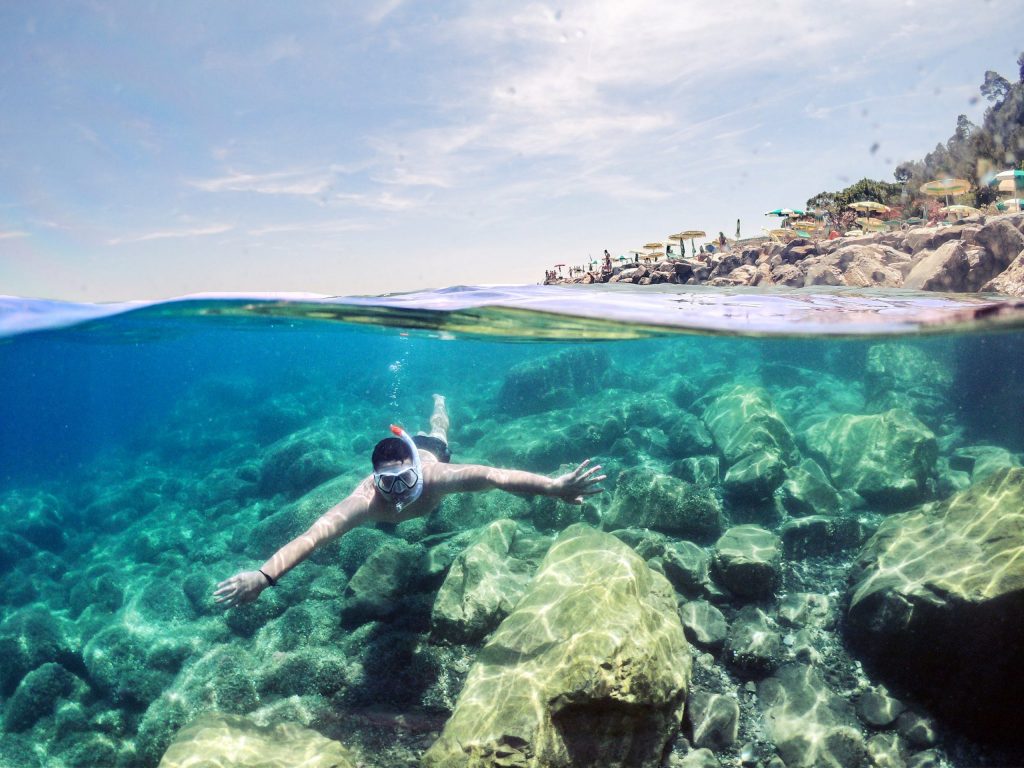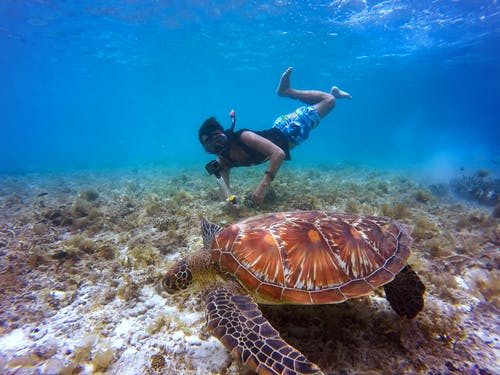Most people who visit Galapagos do so to see the animals, and it’s true that the islands are home to many fascinating species of birds, reptiles, insects and more. Most people don’t necessarily know that the Galapagos are also world famous for diving and snorkeling.
Why the Galapagos Islands are Great for Snorkeling
The Galapagos Islands are strategically located on the equator off the western coast of South America. Every year, currents coming up from South American and down from North America bring rich ocean nutrients. These nutrient-rich waters feed fish and marine plants, which in turn feed sharks, sea turtles and many of the above-water Galapagos animals such as boobys and frigatebirds. The Galapagos marine world does not have much coral, but does feature fish, echinoderms and other sea life in abundance.
The snorkeling in Galapagos is good year-round and visitors can always spot a shark, ray or turtle if they’re lucky. From May to October are the cold months: that’s good news and bad news, because although some swimmers might want a wetsuit, cold water is clearer and the visibility is improved.
Seeing brightly colored reef fish, like parrotfish, surgeonfish, angelfish or sergeant-majors is a given – they’re common at all Galapagos snorkeling sites. Lucky snorkelers can see white-tipped reef sharks, Galapagos sharks, Hammerhead sharks, green sea turtles, manta rays, pacific sunfish and more. Occasionally, playful sea lions will frolic with snorkelers.
How to go Snorkeling in Galapagos
The Galapagos Islands are remote and expensive. Most travelers choose to either book a cruise, which lasts four days to a week, or stay on land in one of the three towns and do day trips. Snorkeling is included on the cruises, which can go to some spectacular sites like the “Devil’s Crown,” a semi-submerged former volcanic crater. From the towns, it’s easy to book half-day snorkeling excursions: most go to places with a lot of sea lions.
Tips and Suggestions for Galapagos Snorkeling
Bring a mask and snorkel. Good ships and tour outfitters will provide them, but their condition may be less-than-optimal. Fins are useful, but the ones provided by the ship or daytrip operator are usually fine.
Practice beforehand. Smart Galapagos travelers will practice with their masks and snorkels before they jump off a rubber boat into a brisk current in chilly water. Snorkeling gear can be taken to a public swimming pool before the trip: even a half hour or so practicing can make a big difference for those not familiar with the use of a mask and snorkel.
Be the first in the water. Some Galapagos marine creatures are shy, like sea turtles, rays and sharks. They may swim off if they see swimmers, so leading the pack is the best way to see them.
Look closely. Some Galapagos sea life, like frogfish and scorpionfish, are camouflaged (see photo). Some hide on sandy sea bottoms, and others in brightly colored plants, corals and rocks: the trick to spotting them is to look closely.
Communicate with the guide: all dives and snorkeling trips must be accompanied by a certified Galapagos naturalist guide. Talk to him or her before the trip and ask what to look for. While snorkeling, stay close, as eagle-eyed guides can spot marine life invisible to novices.
How to Travel the Galapagos Islands
The Galapagos Islands are located in the eastern Pacific Ocean nearly 1000 km from continental Ecuador, which is the country they belong to. Straddling the equator, islands are located in both the northern and southern hemisphere
Why Travel to the Galapagos Islands
The Galapagos Islands were left almost untouched until the their European discovery in 1535. The absence of human presence allowed the islands remain preserved for thousands of years. Since there were no humans to hunt the animals, they have no fear of humans and barely notice your presence as you walk within touching distance (but please don’t touch). Also many of the animals here are found nowhere else making the Galapagos Islands unlike any other place on Earth.
The abundance of animal life above and below the water will please even the biggest critic, but make sure you take a break from animal watching long enough to notice the breathtaking scenery and beautiful white sand beaches. On these islands and in their surrounding waters you can see sea lions, giant tortoises, marine iguanas, lava lizards, penguins, flamingos, blue and red footed boobies, eagles, hawks, albatross, turtles, numerous types of rays and sharks, countless fish, dolphins, whales and many other beautiful creatures. And not just one at a time, but by the hundreds.
How to Get to the Galapagos Islands
The islands are not serviced by international flights, which means first you’ll have to fly into Quito, Ecuador and then from there take a three hour flight to Isla Baltra. This may seem like a head-ache, which it kind of is, but this little catch deters travelers; which leaves the islands nearly deserted (if you don’t count the thousands of animals). From the airport you’ll have to arrange a transfer to Puerto Ayora with your tour company or you can attempt it yourself. It includes a local bus, a small ferry and is pretty straight forward. The locals can be very helpful if you have any questions.
What’s to Offer at the Galapagos Islands
Since the Galapagos are made up of thirteen main islands and six smaller ones by far the best way to see them, and the only way to see some of them, is to join a cruise. Most cruises depart out of Puerto Ayora: a small town with a few hotels, restaurants, travel agents and a bank. Puerto Ayora is also home to the Charles Darwin Research Station. The cruises will travel to either the northern islands, southern islands or both if you have the time and money. A typical tour will travel from island to island while you sleep, leaving the day to tour an island and snorkel at its shallow waters. Most tours range from five to fourteen days and cost $150-$600 per day, meals included. The difference in cost will be due to the size of boat, size of group, meals, sleeping quarters, which islands you visit, English speaking guide, snorkel equipment included and other things of that nature. These things should be discussed and confirmed with your travel agent before departure.
Who Should Go to the Galapagos islands
This is a trip that can be experienced by the whole family, although you will be eating, sleeping and spending a lot of your time on a boat, which may be uncomfortable for young children. There will be a lot of walking, sometimes on semi-unstable terrain. Even though it’s optional, snorkeling is one of the highlights of any trip to the Galapagos so being a strong swimmer would be a major advantage, but don’t let it discourage you if your not. Everyone can enjoy the islands at their own pace so not to worry the lizards sun-bathing on the rocks won’t be moving anytime soon.
Scuba divers can book diving tours but can expect to pay a higher price. One scuba diving recommendation is diving with the schools of hammerhead sharks. You can do this individually in one day from Puerto Ayora.
When to Travel to the Galapagos Islands
You can visit the islands at anytime a year. The warmest time (for the water temperature too) is from November to June but experienced divers say June to November is the best time for underwater sea life. July, August, December and January are the busiest months to visit.
Tips on Travel to the Galapagos islands
Almost the entire archipelago is a national park. There is a park entrance fee payable in only $US dollars so check current price before departure. You will have to pay this before leaving the airport on Isla Baltra.
Bring tried and true snorkeling gear. If not possible, at least bring a mask. Though snorkeling gear should be provided and there are stores to buy some; nothing will ruin your trip more than a leaky mask.
- How to support your child’s mental health: A parent’s guide - February 1, 2025
- Can data centers stay green? Balancing digital growth with clean energy - January 26, 2025
- Why Blockchain could be end of high fees, delays in global payments - January 17, 2025
- Abridge AI: Silent scribe transforming healthcare interactions - January 5, 2025
- What makes quantum AI a game-changer for technology - December 25, 2024
- How businesses must adapt to evolving cyber threats in 2025 - December 4, 2024
- How vaping stiffens blood vessels and strains lungs: Study - November 26, 2024
- OpenAI Codex or Google Codey? Finding the perfect AI for your code - November 18, 2024
- What Google’s Project Jarvis means for future of digital interaction - October 28, 2024
- 11 tips for creating engaging ad content - July 8, 2024




